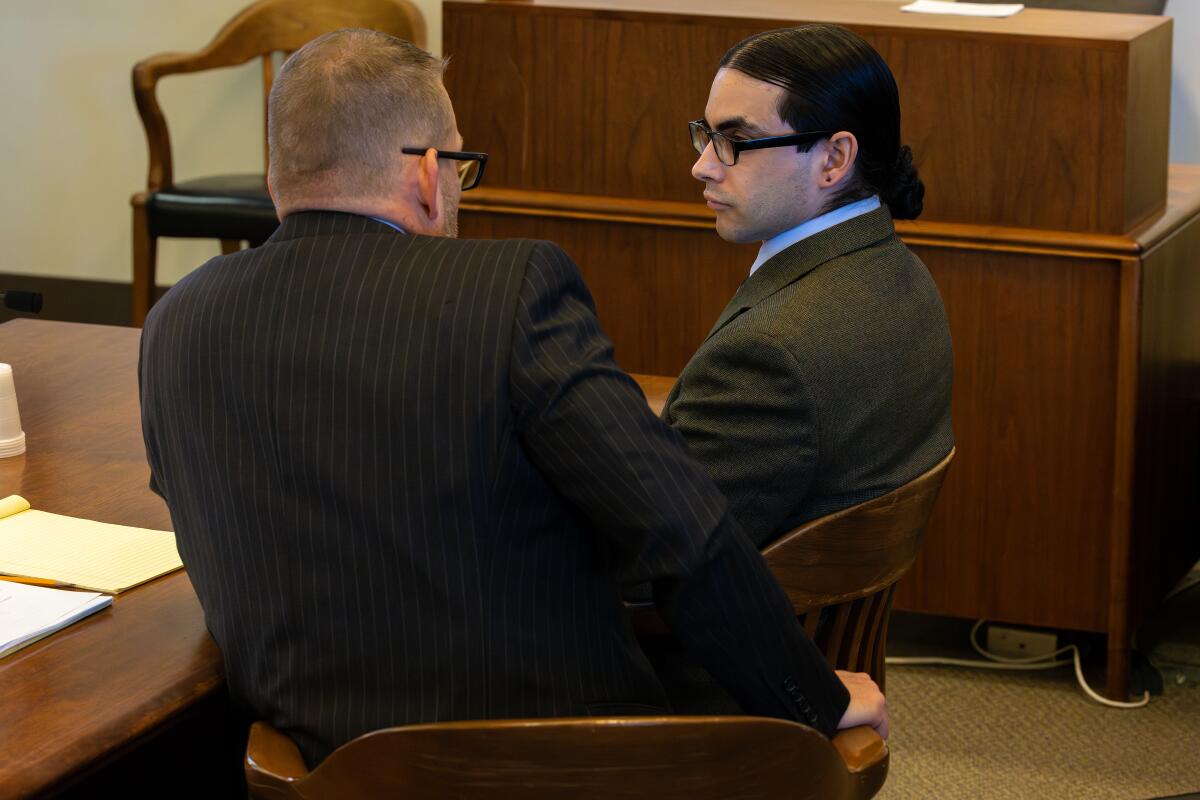Jury begins deliberations in 2021 fatal freeway shooting trial that killed 6-year-old

In closing arguments Wednesday in the trial of Marcus Anthony Eriz for his role in the 2021 freeway shooting death of a Costa Mesa child, the defense sought to lessen a second-degree murder charge to manslaughter.
The case is now in the hands of the jury for its deliberations.
Eriz, 26, of Costa Mesa, stands accused in the incident that resulted in the death of 6-year-old Aiden Leos, on May 21, 2021. The defendant faced the second-degree murder charge and a count of shooting at an occupied motor vehicle, both felonies, and a sentencing enhancement for discharging a firearm, causing death.
The day began with the prosecution and the defense agreeing to a pair of facts in the case: that a bullet passed through Aiden’s liver, lung and heart before exiting through his right abdomen, and that the boy died of a perforating gunshot wound.
Evidence to be considered included a look at comments made by Eriz while being interviewed by investigators. Senior Deputy Dist. Atty. Daniel Feldman submitted to the jury that Eriz told authorities he had been carrying a gun with him in the car for months because people had been “hostile” on the roadways.
The prosecution reminded jurors that Eriz had knowledge about firearms, enough to pass the firearm safety test to possess the weapon and to customize the 9-millimeter Glock pistol with a red stripe across the bottom of its handle. Feldman held up the weapon again for the members of the jury during his closing statement rebuttal.
Feldman argued the second-degree murder charge should hold up under the criteria for implied malice, which include intent to commit an act with consequences dangerous to life, knowledge of that danger, and carrying out the act with conscious disregard for life.
The shooting occurred on the 55 Freeway in Orange. Aiden was riding in the back seat of a vehicle driven by his mother, Joanna Cloonan, en route to a transitional kindergarten class when they were cut off by a vehicle driven by Eriz’s girlfriend, Wynne Lee.
Cloonan caught up with the couple and displayed her middle finger. During her testimony, Cloonan testified that Eriz smiled before firing the shot that traveled through the back of her vehicle before fatally striking her son.
The reasoning behind the smile was also up for debate. Randall Bethune of the Orange County Public Defender’s Office, representing Eriz, argued his client may have been reacting to a “peace sign” shown by his companion, Lee, which he referred to as an apologetic gesture.
Feldman called it a “cold, chilling smile” before Eriz pulled the trigger, questioning the value the defendant put on human life.
Eriz grabbed his gun from behind Lee’s seat, racked a round and rolled down the window before pointing and firing at Cloonan’s vehicle, Feldman said, arguing that the sequence of events required thought and constituted a choice to carry out the act.
The defense countered that the altercation happened almost instantaneously, in a matter of seconds, not allowing opportunity for deliberation.
Bethune implored the jury to consider Cloonan’s act of displaying the middle finger as enough of a provocation to reduce the charge to voluntary manslaughter.
“We’re not asking for an acquittal,” Bethune said. “We’re asking for proper culpability.”
While Bethune contended that people get shown the middle finger all the time and react rashly in the “heat of passion,” Feldman rejected the argument, saying “it might be nasty, it might be rude,” but “getting flipped off is not provocation.”
Eriz did not testify on his behalf, although Bethune said that the statements heard from the interviews showed that he cooperated with investigators in a manner that was “authentic and honest.”
Authorities located the vehicle driven by Lee during the freeway dispute after a search for the suspects lasted for more than two weeks. The vehicle was found in the garage of a Whittier home belonging to a family member.
“He hid the car because it was Wynne’s, and Wynne didn’t do anything wrong,” Bethune added. “That’s why he hid the car.”
All the latest on Orange County from Orange County.
Get our free TimesOC newsletter.
You may occasionally receive promotional content from the Daily Pilot.




